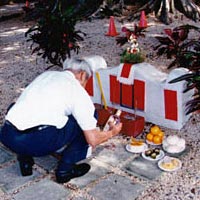
Tin Yau Yee honors his ancestors by spelling whiskey on the ancestral grave, April 1994. Photo: Doug S.Y. Young |
Ching Ming Tradition in Hawai'i
With origins dating back 3,000 years, the practice
of Ching Ming is still observed worldwide by Chinese
families, many miles and generations removed from their ancestral
homeland. Ching meaning "pure" or "clean,"
Ming meaning "brightness," the words together are applied to the
traditional Chinese tradition of ancestor worship, considered by
many to be the original religion of China. Confucius
stated: Filial piety is the law of the universe, the
righteousness on earth, and the correct path of human
behavior. According to anthropologist Francis L.K.
Su, ancestor worship is based on three basic assumptions: 1) all
good fortune or misfortune of a person is derived from the shadows
of his ancestors; 2) all departed ancestors have still the same
physical needs they had when alive; 3) the departed can assist
their relatives in the "Outer World," i.e., earth.
Through countless generations these beliefs have
guided the practices of Ching Ming, which have evolved to
include the trimming of overgrown foliage, weeding, cleaning,
repairing and replanting of ancestral gravesites, ceremonies
involving the presentation of food and symbolic representations of
earthly possessions, and rituals associated with honoring ones
ancestors. It is not necessarily a time of sadness, but reflection,
remembrance and communion with past generations. Held on the fourth
day of April, the event often becomes a family reunion at the
graves of one's ancestors. Another facet of
Ching Ming is
the placing of altars in the home for the daily honoring of the
family line.
Often, because of Western Christian influences,
Ching Ming is today observed more as a traditional and
cultural practice rather than a religious practice. In Hawaii, the
practice has retained a stronger presence than in other parts of
the United States. Customs here include the burning of incense,
offering of prayers, placing foods on the grave, and burning
symbolic paper money. Foods laid out on the grave may include
fruit, rice, wine, chicken, pork, cakes, tea, and dim sum.
Sometimes, along with the food offering, whiskey is spilled on the
gravesite. A meal may be eaten at the gravesite as a gesture of
sharing with deceased relatives.
The Hawaiian Chinese Multicultural Museum &
Archives has documented their project with a five-page written
report, a transcription of a
Honolulu Advertiser newspaper
from April 1984, an information sheet on the Museum & Archives,
and ten 8 x 10 color photographs with captions.
Originally submitted by: Daniel K. Inouye, Senator Daniel K. Akaka, Senator Neil Abercrombie, Representative (1st District) & Patsy T. Mink,Representative (2nd District).
 More Local Legacies... More Local Legacies... |
|
|
|
The Local Legacies project provides a "snapshot" of American Culture as it was expressed in spring of 2000. Consequently, it is not being updated with new or revised information with the exception of "Related Website" links.
|